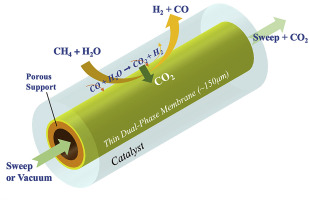当前位置:
X-MOL 学术
›
J. Membr. Sci.
›
论文详情
Our official English website, www.x-mol.net, welcomes your
feedback! (Note: you will need to create a separate account there.)
Hydrogen production with carbon dioxide capture by dual-phase ceramic-carbonate membrane reactor via steam reforming of methane
Journal of Membrane Science ( IF 8.4 ) Pub Date : 2020-03-01 , DOI: 10.1016/j.memsci.2019.117780 Han-Chun Wu , Zebao Rui , Jerry Y.S. Lin
Journal of Membrane Science ( IF 8.4 ) Pub Date : 2020-03-01 , DOI: 10.1016/j.memsci.2019.117780 Han-Chun Wu , Zebao Rui , Jerry Y.S. Lin

|
Abstract The existing process for hydrogen production from methane through steam-reforming requires multiple reactors and separators and is thus costly and energy-intensive. This paper reports a new concept of CO2-permselective membrane reactor for promoting hydrogen production via steam reforming of methane (SRM) with CO2 capture. The membrane reactor is made of a ceramic-carbonate dual-phase membrane with a two-layered asymmetric wall structure. Bismuth-yttrium-samarium oxide (Bi1.5Y0.3Sm0.2O3-δ, BYS) was added to the support layer to make it non-wettable by molten carbonate, leaving the samarium-doped ceria (Sm0.2Ce0.8O2-δ, SDC) layer to form a thin (~150 μm) CO2-permselective SDC/molten-carbonate dual-phase layer after molten carbonate infiltration. The output product composition from the membrane reactor confirms that in situ CO2 removal effectively promotes water-gas shift conversion in SRM and thus enhances hydrogen yield. At 900 °C with feed pressure at 1 atm, the membrane reactor achieves 90% hydrogen yield with 84% CO2 recovery, which poses significant improvement when compared with conventional fixed-bed reactor under similar conditions. Analysis of CO2 permeation activation energy suggests that surface reaction rate might have an effect on CO2 permeation flux for the thin SDC/molten-carbonate membranes. Under atmospheric conditions the CO2 permeation with reactive feed for SRM is lower than with non-reactive feed due to lower driving force under reactive conditions in the feed.
中文翻译:

甲烷蒸汽重整双相陶瓷-碳酸盐膜反应器捕获二氧化碳制氢
摘要 现有的甲烷蒸汽重整制氢工艺需要多个反应器和分离器,成本高、能耗大。本文报道了一种新概念的 CO2 选择性渗透膜反应器,用于通过具有 CO2 捕获的甲烷蒸汽重整 (SRM) 促进氢气生产。膜反应器由陶瓷-碳酸盐双相膜制成,具有两层非对称壁结构。将铋-钇-钐氧化物(Bi1.5Y0.3Sm0.2O3-δ,BYS)添加到支撑层中,使其不可被熔融碳酸盐润湿,留下掺钐的氧化铈(Sm0.2Ce0.8O2-δ, SDC) 层在熔融碳酸盐渗透后形成薄 (~150 μm) CO2 选择性渗透 SDC/熔融碳酸盐双相层。膜反应器的输出产物组成证实,原位 CO2 去除有效地促进了 SRM 中的水煤气变换转化,从而提高了氢气产量。在 900 °C 和 1 个大气压的进料压力下,膜反应器实现了 90% 的氢气产率和 84% 的 CO2 回收率,与类似条件下的传统固定床反应器相比,这带来了显着的改进。CO2 渗透活化能的分析表明,表面反应速率可能对 SDC/熔融碳酸盐薄膜的 CO2 渗透通量有影响。在大气条件下,SRM 反应性进料的 CO2 渗透低于非反应性进料,因为在进料中反应性条件下的驱动力较低。在 900 °C 和 1 个大气压的进料压力下,膜反应器实现了 90% 的氢气产率和 84% 的 CO2 回收率,与类似条件下的传统固定床反应器相比,这带来了显着的改进。CO2 渗透活化能的分析表明,表面反应速率可能对 SDC/熔融碳酸盐薄膜的 CO2 渗透通量有影响。在大气条件下,SRM 反应性进料的 CO2 渗透低于非反应性进料,因为在进料中反应性条件下的驱动力较低。在 900 °C 和 1 个大气压的进料压力下,膜反应器实现了 90% 的氢气产率和 84% 的 CO2 回收率,与类似条件下的传统固定床反应器相比,这带来了显着的改进。CO2 渗透活化能的分析表明,表面反应速率可能对 SDC/熔融碳酸盐薄膜的 CO2 渗透通量有影响。在大气条件下,SRM 反应性进料的 CO2 渗透低于非反应性进料,因为在进料中反应性条件下的驱动力较低。CO2 渗透活化能的分析表明,表面反应速率可能对 SDC/熔融碳酸盐薄膜的 CO2 渗透通量有影响。在大气条件下,SRM 反应性进料的 CO2 渗透低于非反应性进料,因为在进料中反应性条件下的驱动力较低。CO2 渗透活化能的分析表明,表面反应速率可能对 SDC/熔融碳酸盐薄膜的 CO2 渗透通量有影响。在大气条件下,SRM 反应性进料的 CO2 渗透低于非反应性进料,因为在进料中反应性条件下的驱动力较低。
更新日期:2020-03-01
中文翻译:

甲烷蒸汽重整双相陶瓷-碳酸盐膜反应器捕获二氧化碳制氢
摘要 现有的甲烷蒸汽重整制氢工艺需要多个反应器和分离器,成本高、能耗大。本文报道了一种新概念的 CO2 选择性渗透膜反应器,用于通过具有 CO2 捕获的甲烷蒸汽重整 (SRM) 促进氢气生产。膜反应器由陶瓷-碳酸盐双相膜制成,具有两层非对称壁结构。将铋-钇-钐氧化物(Bi1.5Y0.3Sm0.2O3-δ,BYS)添加到支撑层中,使其不可被熔融碳酸盐润湿,留下掺钐的氧化铈(Sm0.2Ce0.8O2-δ, SDC) 层在熔融碳酸盐渗透后形成薄 (~150 μm) CO2 选择性渗透 SDC/熔融碳酸盐双相层。膜反应器的输出产物组成证实,原位 CO2 去除有效地促进了 SRM 中的水煤气变换转化,从而提高了氢气产量。在 900 °C 和 1 个大气压的进料压力下,膜反应器实现了 90% 的氢气产率和 84% 的 CO2 回收率,与类似条件下的传统固定床反应器相比,这带来了显着的改进。CO2 渗透活化能的分析表明,表面反应速率可能对 SDC/熔融碳酸盐薄膜的 CO2 渗透通量有影响。在大气条件下,SRM 反应性进料的 CO2 渗透低于非反应性进料,因为在进料中反应性条件下的驱动力较低。在 900 °C 和 1 个大气压的进料压力下,膜反应器实现了 90% 的氢气产率和 84% 的 CO2 回收率,与类似条件下的传统固定床反应器相比,这带来了显着的改进。CO2 渗透活化能的分析表明,表面反应速率可能对 SDC/熔融碳酸盐薄膜的 CO2 渗透通量有影响。在大气条件下,SRM 反应性进料的 CO2 渗透低于非反应性进料,因为在进料中反应性条件下的驱动力较低。在 900 °C 和 1 个大气压的进料压力下,膜反应器实现了 90% 的氢气产率和 84% 的 CO2 回收率,与类似条件下的传统固定床反应器相比,这带来了显着的改进。CO2 渗透活化能的分析表明,表面反应速率可能对 SDC/熔融碳酸盐薄膜的 CO2 渗透通量有影响。在大气条件下,SRM 反应性进料的 CO2 渗透低于非反应性进料,因为在进料中反应性条件下的驱动力较低。CO2 渗透活化能的分析表明,表面反应速率可能对 SDC/熔融碳酸盐薄膜的 CO2 渗透通量有影响。在大气条件下,SRM 反应性进料的 CO2 渗透低于非反应性进料,因为在进料中反应性条件下的驱动力较低。CO2 渗透活化能的分析表明,表面反应速率可能对 SDC/熔融碳酸盐薄膜的 CO2 渗透通量有影响。在大气条件下,SRM 反应性进料的 CO2 渗透低于非反应性进料,因为在进料中反应性条件下的驱动力较低。











































 京公网安备 11010802027423号
京公网安备 11010802027423号